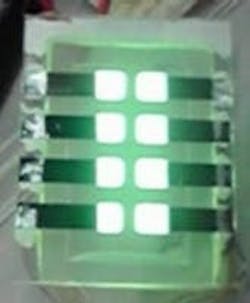Research boosts efficiency of green, blue OLEDs
The OLED device has the bottom-emission type structure, which extracts light through a substrate made with transparent electrodes. In addition, a 0.7mm-thick glass plate with a refraction index as high as 2.03 is bonded to the substrate. The surface of this glass plate is processed to have a structure of about 0.3mm-pitch optical lens array.
When emitting light at a luminance of 10cd/m2, the device had a light-emitting efficiency of 210 lm/W and a light-extraction efficiency of 56.9%. Without the high-refractive glass plate, the efficiency was only 94.3lm/W, or 2.3 times less.
PNNL uses new materials to boost efficiency of blue OLEDs by 25%
New host materials for a blue phosphorescent OLED boost efficiency by at least 25 percent , filling agap in the development of cost-effective white OLEDs, according to researchers at the Pacific Northwest National Laboratory.
At a recent meeting of the American Chemical Society, Padmaperuma presented information on design strategies developed through computational and experimental chemistry for engineering blue OLED materials, and the use of computational chemistry to develop multifunctional emitter materials for blue OLEDs.
Also, PNNL scientist Phillip Koech discussed a novel approach for controlling the doping concentration and molecular diffusion of the dopant material - see press release.
